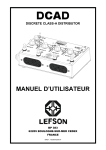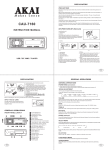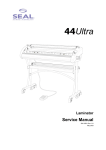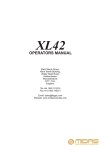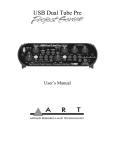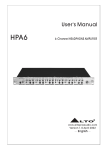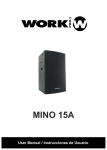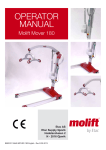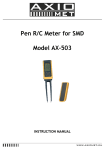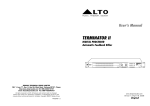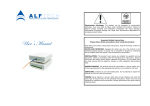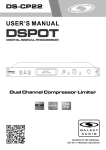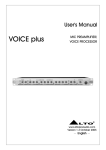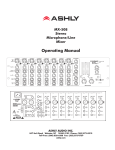Download USER MANUAL
Transcript
DCAD DISCRETE CLASS-A DISTRIBUTOR USER MANUAL BP 383 62205 BOULOGNE-SUR-MER CEDEX FRANCE SIRET : 79336616200014 WWW.LEFSON.COM SAFETY INSTRUCTIONS All the rules listed below apply to the Lefson BT36 and DCAD PROTECTION OF PERSONS The DCAD has some electromechanical protruding parts : lever switch, foot switch and command buttons. These elements combined with the weight of 1.7 kilogram of the device, can cause some physical discomfort or minor injuries in a fall or sharp contact with any part of the human body. The DCAD, as any other electronic device, should be used only under the conditions mentioned in this user manual. Here are the main points about the human person, mentioned in a random order : Never make possible intrusion of material inside the device, whether it be solid or liquid, gas or other flammable components. In places where children are present, always supervise them. Particular attention is to be observed among the youngest. It is imperative to prohibit and prevent the use of the device by any child who is not old enough to understand all the rules of the user manual attached to the product. Never disassemble in any way the device. If disrespectful unscrewing the housing of the device, a button or an other object, be sure to perfectly replace anything. Never leave any part of the device, out of sight or reach of children especially in infancy. Never forget that a child will have for first reflex to bring to one of his five senses any object that he doesn’t know. The risk of accidental swallowing which can be fatal must be constantly controlled. Never open or modify in any way the device (DCAD or BT36). Never store or use the device in harsh environments subject to extreme temperatures, high humidity levels, any wet contact surface or water spray, high levels of vibration, dust of any matter. Never handle or use the DCAD with your hands or other parts of the body, wet or even damp. The device must be protected from any shock that might cause mechnical external, or intern damages that may cause short circuit, overheating, fire or other risk events. Always place the unit in a stable position. Never place it in equilibrium, in inclination or supension. It is essential to ensure that the BT36 and all equipments used, are properly grounded to the electrical installation. Always power the DCAD with its BT36 dedicated supply. The power cable is used as disconnecting tool. The AC power socket must be installed near the equipment and easily accessible. Never excessively twist or bend the power cords. Never walk on or cover them with heavy objects. Do not follow this rule may result in degradation of cords or cables causing malfunctions, failures, bad contacts or in the worst case some short circuits. Deterioration of these elements can cause electric shock or fire starts. -1- DEVICE PROTECTION The devices must be used in an aerated or ventilated place. Do not place them too close each other, so as not disturb their heat dissipation. In the event of a storm, or long inactivity, always disconnect the power transformer (BT36) from the mains voltage. Before cleaning the device or anything else, be sure to disconnect the BT36 from the mains voltage. When connecting or disconnecting the DCAD or the BT36, always hold the connector (plug), not the cable or cord. Never short circuit the connector of the power cord, otherwise overheating and fire risk from the power transformer. Periodically it is necessary to clean the power connectors with a dry cloth to remove any dust on their electrical contact surfaces. Be sure to unplug the power transformer (BT36) prior to the operation. An accumulation of dust on an electric surface can induce a risk of fire. If disrespectful unscrewing the housing of the device, a button or other object, be sure to fully replace any element, to not create areas suitable for the intrusion of foreign bodies. Avoid to entangle cables or cords. Always dispose them orderly and put them out of reach of children. In case of smoke from the device, odor, noise or visual doubtful manifestation, immediately unplug the transformer (BT36) from the mains voltage and contact the Lefson company. Never place heavy objects, or exercising any pressure, on the unit or against one of its surfaces. Never carry or use the device, the power transformer, or any cable, cord or connector by hand or other part of the body, wet or just damp. This exclamation point on the product is intended to alert the user about the presence of important information provided in the user manual. It is important to read them before any other action. These icons on the cover of the Lefson BT36 are intended to alert the user about the presence of high voltage inside the device and thus, the imminent risk of electric shock if disassembling the unit. All information relating to the safety are listed in this user manual. It is essential to read it before use. NOTICE TO CUSTOMERS The BT36 and DCAD are delivered with a warranty card which must be completed and returned by the user to be validated and taken into account. Remember to use the correct value of powering according to the voltage in the country of use. Any breach of any rule in this manual will cancel the warranty of the equipment. Copyright © 2013 LEFSON All rights reserved. No part of this publication may be reproduced in any form without the permission of the LEFSON company. -2- Declaration of conformity . Application of directives : 2006/95/CE – 2004/108/CE . Standards to which conformity is declared : CISPR22 (2008) CISPR24 (2010) IEC 61000-3-2 (2009) IEC 61000-3-3 (2008) Publication CFR47 part 15 of 2012 ICES-003 of 2012 IEC 60950-1:2005 (2nd Edition) + Am1:2009 EN 60950-1:2006 + A11:2009 + A1:2010 + A12:2011 . Manufacturer’s name : LEFSON . Manufacturer’s adress : BP 383 – 62205 Boulogne-sur-Mer Cedex – France . Type of equipment : Class-A Audio distributor, with its 115/230V external power supply . Name of the model : DCAD + BT36 . Notified body : LCIE Bureau Veritas – Fontenay-aux-Roses - FRANCE I, the undersigned, hereby declare that the equipment specified above conforms to the above directives and standards. Boulogne-sur-Mer, October 21, 2013 XAVIER LEFEBVRE Director, engineer -3- INTRODUCTION Congratulations and thank you for choosing a Lefson DCAD. This device is the result of hundreds hours of research and audiophile electronic experimentations. Everything in the Lefson DCAD has been carefully designed to assure you of exceptional performance regardless of the circumstances. We are sure that this device will provide you hours of listening pleasure, satisfaction, and that it will quickly become an indispensable tool for developing your creativity. Your DCAD and its dedicated BT36 power supply are designed according to strict rules. The quality of any element was taken into account. The DCAD is an audio class-A distributor. Its circuits are made of highquality analog components. It is assembled in our workshop in France, entirely by hand, according to our own rules of assembly and testing procedures. Before being sold, your DCAD was electrically and audibly measured to ensure an optimal operation in the coming decades. Prior to any action, please take the time to read this manual completely, beginning with the safety instructions previously outlined. 100% Analog, 100% Discrete, 100% Class-A Nowadays it is usual to use audio distributors. One often underestimate the importance of these devices. Generally located at the beginning of the audio chain, they influence the audio signal through its full path. This is about what Lefson decided to impose itself by creating an unique device, the DCAD : Discrete Class-A Distributor. Its analog circuitry of audiophile quality demonstrate that it’s all about discipline, intransigence and know-how. The DCAD, with its incredible sonic performances, innovations, and the accuracy of its many options, will satisfy both the instrumentalist and the most experienced engineers. The device is designed to resolve technical disputes occurring during studio recording or on stage. -4- DESCRIPTION The Lefson DCAD "Discrete Class-A Distributor" is an audio distributing device with five active outputs. This unit, like all of the Lefson brand, is particularly designed for audio professionals. It is able to duplicate any audio signal applied on one of its three inputs "INSTR, SPEAKER, MIC/LINE", perfectly on six outputs, simultaneously. One of these outputs, called "THRU" is directly connected in parallel to the "INSTR" input. Four others, "ISO 1" to "ISO4" are equipped with their own active circuit, an electrical isolation, and can be enabled or disabled by a dedicated foot switch. A last one, "5:1 DIRECT OUTPUT" is always enabled and has the same isolation as the four previous. The selection of the various options of operation is performed by multiple switches and a potentiometer. Their role is illustrated by a screen printing directly on the device. The visualization of the power of DCAD, the activation of the four outputs "ISO1" to "ISO4", and the activation of 48V power, is made possible by the use of LED indicators of different sizes and colors. All the audio sockets of the DCAD are manufactured by the famous NEUTRIK company. The Lefson DCAD can be connected to any other device with a standard +4dBu or -10dBu audio level. As the outputs active stages are provided with low impedance and balanced circuitries, the Lefson DCAD is very "strong" with electrical charges that are submitted to it and can be connected to other devices with long cables, while minimizing the various problems related to the interference phenomena. Many safeguards are implemented in both the supply and the audio circuit, allowing the DCAD to withstand many bad conditions of use without its overall operation being disturbed or damaged. To operate the DCAD needs to be connected to an alternative 36V power supply : the Lefson BT36. It only consists of a transformer, as all elements like rectifiers and filters, generating the voltage required to operate the active electronics, are included into the DCAD. To be sure to get the best results, LEFSON has decided to use an highend AMPLIMO toroidal transformer. This choice has been validated by many audio tests. -5- GETTING STARTED The Lefson BT36 is dedicated to the Lefson DCAD. It was designed to power it with 36V alternative low voltage. As the outputs of the DCAD are floating, it is essential to ensure that the BT36 and all equipment used are properly grounded to the electrical installation. To get started the DCAD with the BT36, it is imperative to proceed in the following order: 1- Check that the two slide switches « VOLTAGE SELECTION » of the BT36 are in a similar position corresponding to the value of the main voltage in your country, 115V or 230V. 2-Connect the DCAD to the BT36 with the provided AC 36V 4 pins power cable. 3-Connect the AC main power cable to the main power socket. BT36, then to the 4-Flip the "POWER" switch in "I" position. The red indicator of the BT36 is now lighting, like those of the DCAD. -6- DESCRIPTION OF THE ARCHITECTURE DCAD -7- 1………Light indicator of the 48V phantom power activation 2………Power LED indicator 3………XLR socket of the 5:1 DIRECT OUTPUT 4………Unbalanced/balanced (TS/TRS) selector of the ISO 4 output 5………Phase inverter of the ISO 4 output 6………Impedance selector of the ISO 4 output 7………Light indicator of the ISO 1 output activation 8………Socket of the 36 Vac power supply 9………Foot switch of the ISO 1 output activation 10……Input source selector 11……Activation switch of the 48V phamtom power supply 12……JACK socket of the MIC/LINE input 13……PAD attenuator knob 14……JACK socket of the INSTR input 15……JACK socket of the THRU output 16……JACK socket of the SPEAKER input 17……JACK socket of the ISO 1 output 1. Light indicator of the 48V phantom power activation As soon as the 48V phantom power is activated, this orange LED lights up. 48V voltage is then present on the MIC/LINE socket. 2.Power LED indicator Once the unit is turned on, this green LED lights up, indicating a proper operation. 3.XLR socket of the 5:1 DIRECT OUTPUT The connection to the balanced 5.1 DIRECT OUTPUT is performed using a 3 pins male XLR socket. 4.Unbalanced/balanced (TS/TRS) selector of the ISO 4 output This selector determines the coupling of the ISO 4 output. The description here applies too to the ISO 1, ISO 2 and ISO 3 outputs. In TS position the output is unbalanced, and in TRS position it is balanced. -8- 5.Phase inverter of the ISO 4 output The reversed-phase inverter, as its name suggests, reverse the phase of the audio signal. This concept of inversion is important to understand: the signal phase is shifted in time but instantly reversed. This inversion occurs over an interval of a half period of the signal or 180 °. The term of « opposite phase » is generally used. In position 0 ° the phase signal is not changed, and in position 180° the signal is 180 ° out of phase. The other three outputs ISO 1, ISO 2 and ISO 3 also have such an inverter. 6.Impedance selector of the ISO 4 output This rotary switch determines the impedance of the ISO 4 output. Six values are available : 2 Ohm, 10k, 22k, 33k, 47k, 82k Ohm. The user has the choice between a very low output impedance and high output impedance. The purpose of it is to simulate the impedance of an instrument microphone. In some configurations it will produce a different sound because it is possible that the user connects the DCAD to devices which will respond very differently if they are driven by low impedance signals. However if no requirement is requested, the low output impedance should be preferred. This choice preserves the audio signal from dropouts. The other three outputs ISO 1, ISO 2 and ISO 3 also have such a selector. 7.Light indicator of the ISO 1 output activation As soon as the ISO 1 output is activated, this red LED lights up. The other three outputs ISO 2, ISO 3 and ISO 4 also have such a LED. 8.Socket of the 36 Vac power supply This socket (BINDER 711 type) must be connected to the dedicated Lefson BT36 power supply, thanks to the provided cable. Never leave the BT36 on when the BINDER 36 Vac power socket of the DCAD is not connected. 9.Foot switch of the ISO 1 output activation ISO 1 output can be turned on or off (muted) depending on the position of the foot switch. It has two positions: on or off, it enables or disables the output. The other three outputs ISO 2, ISO 3 and ISO 4 also have such a foot switch. -9- 10.Input source selector The INPUT source selector allows to select the input to use : INSTR, SPEAKER, MIC, LINE. As the SPEAKER input is designed to process very high level signals, IT IS IMPERATIVE NOT TO BE CONFUSED WITH ANOTHER ONE. 11.Activation switch of the 48V phamtom power supply This switch allows to enable or disable the 48V phantom power. 12.JACK socket of the MIC/LINE input This 6.35mm balanced jack socket is designed to receive signals from microphones or -10/+4 dBu lines. If the 48V phantom power is not requested, care must be taken to disable it with the #11 switch. 13.PAD attenuator knob This knob allows the adjustment of the PAD attenuator. position, the attenuator is disabled. The adjustment range is -60dB and the MIN positions. In OUT between 14.JACK socket of the INSTR input This 6.35mm unbalanced jack socket is designed to receive the high impedance signal of any electrical or electro-acoustic instrument (guitar, bass, cello, bass, synth ...) and more generally any asymmetric signal source (dynamic microphone, -10/+4 dBu line output, pedal and dynamic or time effect processor...). 15.JACK socket of the THRU output This 6.35mm unbalanced jack socket allows a parallel connection to the #14 INSTR input. Be careful because its use will change the overall input impedance of the DCAD. If the THRU output is used, the input impedance of the DCAD becomes equivalent to the input initial impedance of the DCAD in parallel with the input impedance of the device connected to the THRU input. This may be needed if the user does not want to disturb the sound of its configuration, established before the acquisition of DCAD. - 10 - 16.JACK socket of the SPEAKER input This 6.35mm unbalanced jack socket is designed to receive the signals of very high power amplifiers, including instruments amplifiers (guitar, bass, synth ...). From a parallel connection to the speakers, the great advantage of such a connection is to recover the sound of the power amplifier in use. Each amplifier has its own sound, its own sound signature. In the case of an instrument amplifier, it becomes possible to "capture" the sound signature of the preamplifier stage with the power amplifier stage. It is thus possible to make live sound takes using direct connections. The amplifier must have at least one speakers parallel output. If it is not the case, do not use this option. The SPEAKER input of the Lefson DCAD can receive signals from an amplifier whose power does not exceed 600W under 16 Ohm, in other words : an AC signal up to 42 dBu. NEVER USE AN INSTRUMENT AMPLIFIER WITH ITS SPEAKER(S)DISCONNECTED. Familiar users with instrument amplifiers can assimilate this option as an auxiliary power output of the audio signal. 17.JACK socket of the ISO 1 output This 6.35mm jack socket is the connection of the ISO 1 output. The description here applies to the ISO 2, ISO 3 and ISO 4 outputs. The output circuit has its own active CLASS-A transistor and total galvanic isolation transformer. It can be unbalanced or balanced. - 11 - - BT36 - 1 3 7 4 5 - 12 - 1. Socket of the 36Vac power supply The female 36 V AC SUPPLY socket provides power to the Lefson DCAD using the supplied cable. 2. Light indicator of the power supply This indicator allows to visualize the powering of the BT36. 3.Power switch This POWER switch is used to power on or off the BT36. 4.Socket of the main power supply This male socket provides the main 115V or 230V power to the Lefson BT36 using the supplied cable. 5.115V-T315mAL250V fuse holder Before removing anything, ALWAYS ENSURE TO DISCONNECT THE UNIT FROM THE MAINS POWER. Quick access to the fuse is available through this holder. Just grab its cap by pushing it slightly and then turning to the left. If necessary, always try to replace the fuse by another one of the same value : T315mAL (T:temporised), 250V. 6.230V-T160mAL250V fuse holder Before removing anything, ALWAYS ENSURE TO DISCONNECT THE UNIT FROM THE MAINS POWER. Quick access to the fuse is available through this holder. Just grab its cap by pushing it slightly and then turning to the left. If necessary, always try to replace the fuse by another one of the same value : T160mAL (T:temporised), 250V. 7.Voltage Selectors BEFORE POWERING THE BT36, ALWAYS CHECK THAT THOSE SELECTORS MATCH THE CORRECT POSITION CORRESPONDING TO THE VALUE OF THE USED VOLTAGE. If the BT36 is supplied from a 115V mains, place both selectors in 115V position (up). If the BT36 is supplied from a 230V mains, place both selectors in 230V position (down). Both selectors ALWAYS must be used in a similar position. - 13 - SPECIFICATIONS - DCAD – Environmental Specifications* Operating temperature Relative humidity Altitude** *Recommended operating +5 à 30 deg. C 20 à 80 % 0 à 3000m ** Above sea level Physical Specifications Dimensions (mm) Dimensions of the box (mm) Weight Supply 239,8 x 161,1 x 87,8 222,3 x 146,6 x 54,9 1770g External 36 Vac – Lefson BT36 – 4 pins cable 6.1 W Power Peak Level Terms : load = 600ohms ; frequency = 1kHz INSTR input SPEAKER input MIC input LINE input ISO1 to ISO4 outputs 5:1 DIRECT output +25dBu (internal limiter) +42dBu +11dBu (PAD out + internal limiter) +25dBu (PAD out + internal limiter) +23dBu +9dBu Impedance Terms : frequency = 1kHz INSTR input SPEAKER input MIC input LINE input ISO1 to ISO4 outputs 5:1 DIRECT output 1.7M ohms 68k ohms 1k ohms 3k ohms 2/10k/22k/33k/47k/82k ohms 0.08 ohms - 14 - Frequency Response Terms : - measurement reference = 1kHz - source = 1 Volt RMS ; 50ohms INSTR input --> ISO1 to ISO4 outputs INSTR input --> 5:1 DIRECT output LINE input --> ISO1 to ISO4 outputs LINE input --> 5:1 DIRECT output +0.9dB ; 20Hz to 100kHz +/-0.3dB ; 20Hz to 100kHz +0.5/-3dB ; 20Hz to 60kHz -3dB ; 20Hz to 60kHz Gain Terms : - source = 1 Volt RMS/50ohms ; frequency = 1kHz INSTR input --> ISO1 to ISO4 outputs INSTR input --> 5:1 DIRECT output SPEAKER input --> ISO1 to ISO4 output SPEAKER input --> 5:1 DIRECT output MIC input --> ISO1 to ISO4 outputs MIC input --> 5:1 DIRECT output LINE input --> ISO1 to ISO4 outputs LINE input --> 5:1 DIRECT output 1.004 0.194 0.0099 0.0019 4.990 0.970 1.247 0.241 Signal to Noise Ratio Terms : - source = +12dBu/600ohms ; frequency = 1kHz - 80kHz low-pass filter INSTR input --> ISO1 to ISO4 outputs INSTR input --> 5:1 DIRECT output LINE input --> ISO1 to ISO4 outputs LINE input --> 5:1 DIRECT output < < < < 94dB 91dB 96dB 91dB Common Mode Rejection Ratio (CMRR) Terms : - source = +18dBu/50ohms - ground referenced - 80kHz low-pass filter MIC input < < < < < < LINE input 95dB 75dB 55dB 90dB 70dB 50dB @ @ @ @ @ @ 20Hz 1kHz 10kHz 20Hz 1kHz 10kHz Total Harmonic Distortion (THD) Terms : - source = 1 Volt RMS/600ohms ; frequency = 1kHz - 80kHz low-pass filter INSTR input --> ISO1 to ISO4 outputs INSTR input --> 5:1 DIRECT output LINE input --> ISO1 to ISO4 outputs LINE input --> 5:1 DIRECT output - 15 - < < < < 0.009 0.008 0.016 0.014 % % % % Inputs/Outputs Types INSTR input SPEAKER input MIC/LINE input THRU output ISO1 to ISO4 outputs 5:1 DIRECT output Unbalanced Unbalanced Balanced Unbalanced Unbalanced / Balanced – Floating Balanced – Floating Types of Connections 36V AC power supply BINDER 693 PIN 1 : AC 36V (live) PIN 2 : AC 36V (neutral) PIN 3 : NC PIN E : Earth NEUTRIK - JACK TS – 6.35mm TIP : Signal SLEEVE : Ground NEUTRIK - JACK TS – 6.35mm TIP : Signal SLEEVE : Ground NEUTRIK - JACK TRS – 6.35mm TIP : (+) Signal RING : (-) Signal SLEEVE : Ground NEUTRIK - JACK TS – 6.35mm TIP : Signal SLEEVE : Ground NEUTRIK - JACK TS/TRS – 6.35mm TIP : (+) Signal RING : (-) Signal SLEEVE : NC NEUTRIK – 3 points XLR PIN 1 : NC PIN 2 : (+) Signal PIN 3 : (-) Signal INSTR input SPEAKER input MIC/LINE input THRU output ISO1 to ISO4 outputs 5:1 DIRECT output - BT36 – The Lefson BT36 is a 36V alternative low voltage power supply, dedicated to the Lefson DCAD. The BT36 works with both 115V and 230V mains voltages. Two voltage selectors "VOLTAGE SELECTION" allow this choice. They must be properly switched depending on the value of the voltage used. In all cases the two slide switches must have the same position. A fuse and varistor protection is included. The aluminum housing of the BT36 is connected to earth. The electrical connection is made via a standard IEC C14 male socket. The connection to the DCAD is made by using a female Binder 693 type socket. - 16 - As part of the evolution of the product, these features may have to change. Environmental Specifications* Operating temperature Relative humidity Altitude** *Recommended operating +5 à 30 deg. C 20 à 80 % 0 à 3000m ** Above sea level Physical Specifications Dimensions (mm) Dimensions of the box (mm) Weight Supply Current Frequency Output voltage 115V powering fuse 230V powering fuse 182,7 x 137,5 x 68,2 171,5 x 120,6 x 54,9 1060g 115/230V AC 0.26/0.13A 50/60 Hz 36V AC T315mAL250V (temporised) T160mAl250V (temporised) Types of Connections POWER supply 36VAC SUPPLY low voltage output Male socket - IEC C14 Female socket - BINDER 693 PIN 1 : AC 36V (live) PIN 2 : AC 36V (neutral) PIN 3 : NC PIN E : EARTH Note : In the interest of the development of the device, characteristics and/ or drawing may change without notice. Accessories : Luxurious carrying case, 36Vac 4 pins cable, IEC power cable with European, English or American standards, User Manual, Warranty Card. NOTES _______________________________________ _______________________________________ _______________________________________ _______________________________________ _______________________________________ - 17 - Discrete Class-A Distributor DCAD Session Recall Sheet © LEFSON – BP 383 - 62205 Boulogne-sur-Mer Cedex – FRANCE – www.lefson.com – Phone : +33(0)671 434 503 Siret : 79336616200014 - 18 - Discrete Class-A Distributor DCAD Session Recall Sheet SESSION : ........................... DATE : .............................. INSTR THRU SPEAKER MIC/LINE ISO1 ISO2 ISO3 ISO4 DIRECT 5:1 OUTPUT VOLTAGE SELECTION 115V 230V © LEFSON – BP 383 - 62205 Boulogne-sur-Mer Cedex – FRANCE – www.lefson.com – Phone : +33(0)671 434 503 Siret : 79336616200014 - 19 - 20 WWW.LEFSON.COM

























